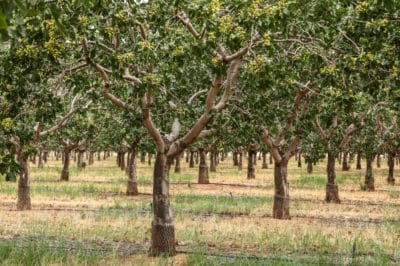USDA Hardiness Zones
Their climate preference is the most finicky characteristic of usually low-maintenance {link u=do-pistachios-grow-on-trees]pistachio trees[/link]. While The USDA rates them as suitable for plant hardiness zones 7b through 10, that’s far from the entire story. In order to produce nuts within those zones, the trees also need:
- Spring winds strong to carry pollen between the male and female trees.
- Minimal rain or humidity during spring and summer, so fungal diseases don’t pose a constant threat.
- Fall and winter months with at least 850 hours of temperatures in the 34° and 45°F (1° and 7.2°C) rage. These chilling hours are essential for their nut development.
In other words, if you’re in a part of USDA zones 7b through 10 where the above conditions apply, your first backyard pistachio harvest could be just a few years away!
Know Before You Grow
All pistachio trees are dioecious, meaning they have either female or male flowers. Only female flowers become fruit. (A pistachio tree’s nut is actually the seed of its fruit.) Without growing both a female and male tree, you won’t have any nuts to harvest. To complicate matters, not just any female-male pairing will do.
Compatible Cultivars
Unless the male and female pistachios you plant flower at the same time, pollination can’t occur. So it’s critical to select compatibly blooming cultivars. Good matches include:
- Female ‘Kerman’ with male ‘Famoso.’
- Females ‘Golden Hills,’ ‘Lost Hills’ or ‘Kaleghouchi’ with male ‘Randy.’
If you’re planning an orchard, plant one male pistachio tree for every 10 to 15 females.
Pistachio Planting Site
Along with pomegranates and figs, pistachios are among the fruit trees that relish desert conditions. Other than needing a well-drained site, they tolerate almost any soil– including an alkaline, saline or rocky one. Their ideal location, however, has well-drained sandy loam with a mildly alkaline pH between 7.1 and 7.8 and little or no shade.
Expert gardener’s tip: : Many of the longest-producing pistachios in the world grow in the high deserts of Iran and Turkey, some 4,500 feet above sea level.
Room to Grow
A mature pistachio seldom measures taller than 30 feet, with a similar spread. Most commercial plantings allow 15 to 18 feet between individual trees and 20 to 22 feet between orchard rows. In simpler terms, a 1/4-acre planting site accommodates about 30 pistachio trees. So growing just two requires very little real estate.
Pistachio Care
Given the right climate and planting site, pistachios are relatively easy-care trees. Their greatest need is for supplemental water (up to 50 gallons a day between flowering and harvest). Water slowly with a drip system or soaker hose. To discourage fungal disease, never allow water to pool on the soil for more than 48 hours.
Fertilizer
Pistachios use lots of nitrogen to fuel their developing nuts. Supply it organically by working 25 pounds of well-aged, grass-fed steer manure into the soil around each tree in mid- to late May. Water the trees well after fertilizing them.
Mineral Supplements
Although they adapt well to poor soils, young pistachio trees sometimes develop mineral deficiencies. To keep them healthy, spray their leaves with a copper, boron and zinc solution every three weeks for the first three years after planting.
Spray older trees with zinc three times a year: when their buds break in March, when they flower in April and as they are entering dormancy in October. If they need it, add boron to the spring applications.
What to Expect
Provided with a proper planting site, plenty of water and adequate nutrients, pistachio trees typically start producing harvestable nuts in five to six years. A first crop seldom exceeds about 5 pounds of nuts. That amount gradually increases to about 50 pounds with the 10th harvest. Healthy trees, however, may produce crops for hundreds of years!
Expert gardener’s tip: Because pistachios are alternate-bearing trees, meaning they’ll produce a heavy harvest one year followed by a much lighter one the next. This is a natural phenomenon, so regular watering and selective pruning will decrease but not prevent it.
